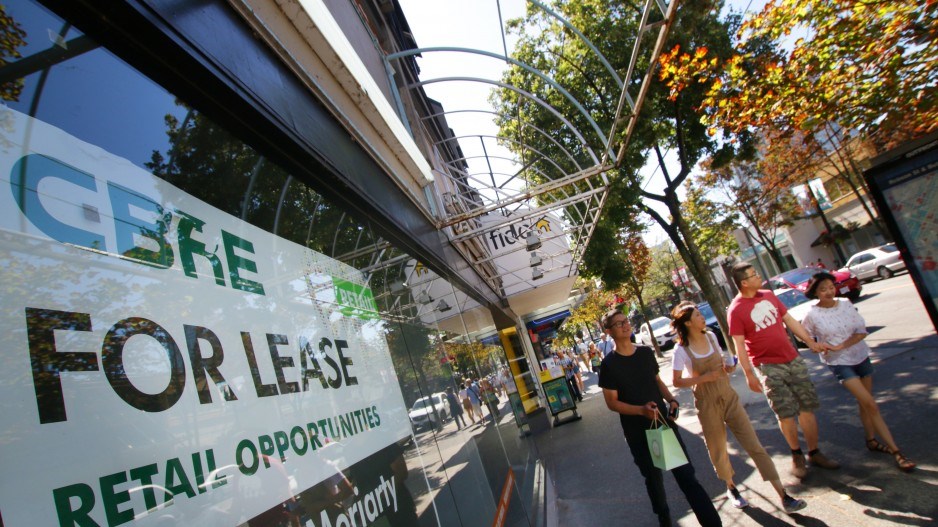What happened: B.C. adds jobs in August, unemployment rate goes down
Why it matters: Latest data shows the province’s rate of recovery isn’t quite matching that of prior months
B.C.’s summer of economic recovery closed off with 15,300 jobs added in August, showing signs massive growth over the preceding two months is now slowing.
Data from Statistics Canada released Friday (September 4) reveals the province’s unemployment rate dropped 0.4 percentage points to 10.7% last month.
Nationwide, the country added 246,000 jobs to the economy — “a tad shy of expectations,” BMO chief economist Douglas Porter told investors — and the unemployment rate fell 0.7 percentage points to 10.2%.
Ken Peacock, chief economist for the Business Council of B.C., said in normal times a 15,000 monthly gain would make for a strong showing.
“But in this [COVID-19] context, 15,000 represents a pretty dramatic slowing,” he said, adding he expected the province to post anywhere between zero to 40,000 jobs in August.
“The low-hanging fruit sectors that were hardest hit, a lot of that rehiring has taken place in the past couple of months.”
Peacock said he does not expect robust numbers moving into the fall.
The West Coast posted gains of 70,200 jobs in July and 118,100 jobs in June.
“The pace of employment growth is slowing, but that was expected with the initial recovery-boost from easing virus containment measures in the spring fading through the summer,” RBC senior economist Nathan Janzen wrote in a note to investors.
“To be clear, labour markets are still very weak. [National] employment is still down more than a million from February, even after the August gain. The unemployment rate fell to 10.2% but that is still above the peak rate during the 2008-09 recession. The number of those on layoff is still exceptionally elevated … But conditions continue to improve, even if at a more gradual pace.”
Prior to the pandemic, B.C. consistently had the lowest unemployment rate among all provinces.
But deep hits to the tourism sector and other industries now see it outperforming only Alberta, Prince Edward Island, and Newfoundland and Labrador.
Unemployment in Metro Vancouver, in fact, rose to 12.4% last month, up from 11.6% in July with the region more dependent on service-oriented jobs than the rest of the province.
B.C.’s biggest gains in August were seen in manufacturing (+6,000 jobs); accommodation and food services (+6,400 jobs); agriculture (+6,600 jobs); and other services, except for public administration (+10,400 jobs).
While the province added jobs overall last month amidst the pandemic, losses were felt in wholesale and retail trade (-10,400 jobs); professional, scientific and technical services (-10,800 jobs); and information, culture and recreation (-6,000 jobs).
Full-time jobs accounted for 13,300 of the total job gains, while part-time work accounted for 2,000 jobs — a sign of healthy recovery owing to the more stable nature of full-time work.
But Peacock said he remains “cautious” about job numbers that appear to be so strongly tilted towards full-time work amidst the pandemic.
He and the Business Council of B.C. are calling on the province to extend layoff provisions in legislation.
That would allow companies to avoid making decisions on either rehiring workers before there is enough revenue coming in or else being forced to cut their jobs permanently and offer severance.
The latter prospect may push many businesses into bankruptcy if they don’t have sufficient capital to pay out employees.
Peacock said the province should also continue pursuing public infrastructure projects bolstered by private capital to keep job growth humming.
But he cautioned many of the jobs lost in the pandemic will not be coming back and that the province should be investing in skills retraining for workers.
Peacock also suggested the province consider cutting the PST in half for a set period of time, such as one year, to help both businesses and households.
He called the PST cut a “triple benefit” as it would allow businesses to pay less on inputs, offer relief to households and encourage capital investments in machinery, equipment and computers.
“Looking ahead, it will be difficult for the labour market to maintain the current pace of job gains. Employment growth has already started to slow and pandemic-related uncertainty is weighing on business hiring decisions,” TD senior economist Sri Thanabalasingam said in a note to investors, referring to the national data.
“Indeed, future employment improvements will be closely tied to the path of the virus. This final third could be the longest stretch in the road to recovery for Canada's labour market.”




